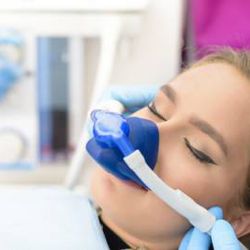
It is estimated that 75 percent of Americans have some degree of anxiety when it comes to visiting the dentist. For approximately 30 to 40 million of those people, that fear is enough to keep them from visiting their dentist regularly. While outright avoidance of the problem may provide temporary comfort, skipping the dentist altogether can have dire consequences for your teeth. Thankfully, there are ways to help those plagued with fear relax during any dental appointment.
One of the most common and effective ways to treat dental anxiety is with nitrous oxide, or laughing gas. Used successfully in dental treatments since 1844, nitrous oxide is a chemical compound comprising an oxide of nitrogen (N2O). Nitrous oxide gets its nickname, “laughing gas,” from the calming, often joyful feeling patients get when inhaling it. Dentists like Martin Abelar of San Diego, California, administer laughing gas through oxygen tubing fitted over the nose during the patient’s procedure.
So, how does it work?
“Nobody really knows,” says Abelar “What we do know is that it inhibits the NDMA receptors in the brain while simultaneously stimulating GABA receptors, which is a fancy way to say it acts as an anesthetic. But instead of just masking pain, it stops the transmission of pain.”
As for how it gets that reputation as “laughing gas,” Abelar says a common side effect of nitrous oxide is a feeling of euphoria.
“Most patients who use nitrous oxide report feeling relaxed, calm or even a little bit silly,” says Abelar.
But there are always cases where this doesn’t happen.
“As with any drug, there are people who don’t respond as well to nitrous oxide,” explains Abelar. “In very rare instances, people can become agitated or scared, but we see that very infrequently.”
Still, despite these cases, Abelar says that nitrous oxide is perfectly safe when given under medical supervision.
“The nitrous oxide we use in medical practice is mixed with oxygen, so the patient is never inhaling pure nitrous oxide,” he says. “Pure, undiluted nitrous oxide can be deadly, which is why we see so many deaths from people abusing it recreationally.”
Of course, there are always other options, such as prescription sedatives that can be taken prior to your appointment, or general anesthesia, but Abelar says those options are usually reserved for patients undergoing a prescheduled procedure.
“We try not to completely sedate a patient unless absolutely necessary, because it makes it difficult to consent if we need to perform additional work,” he says.
Furthermore, patients undergoing full sedation require transportation to and from their procedure, and may be unable to return to work on the day of their sedation.
“Nitrous oxide is just more practical in most cases, and unlike prescription or IV sedatives, once we take the mask off you can go back to your normal routine without any side effects or special arrangements,” Abelar says. “It makes a substantial impact, but with a small footprint.”






